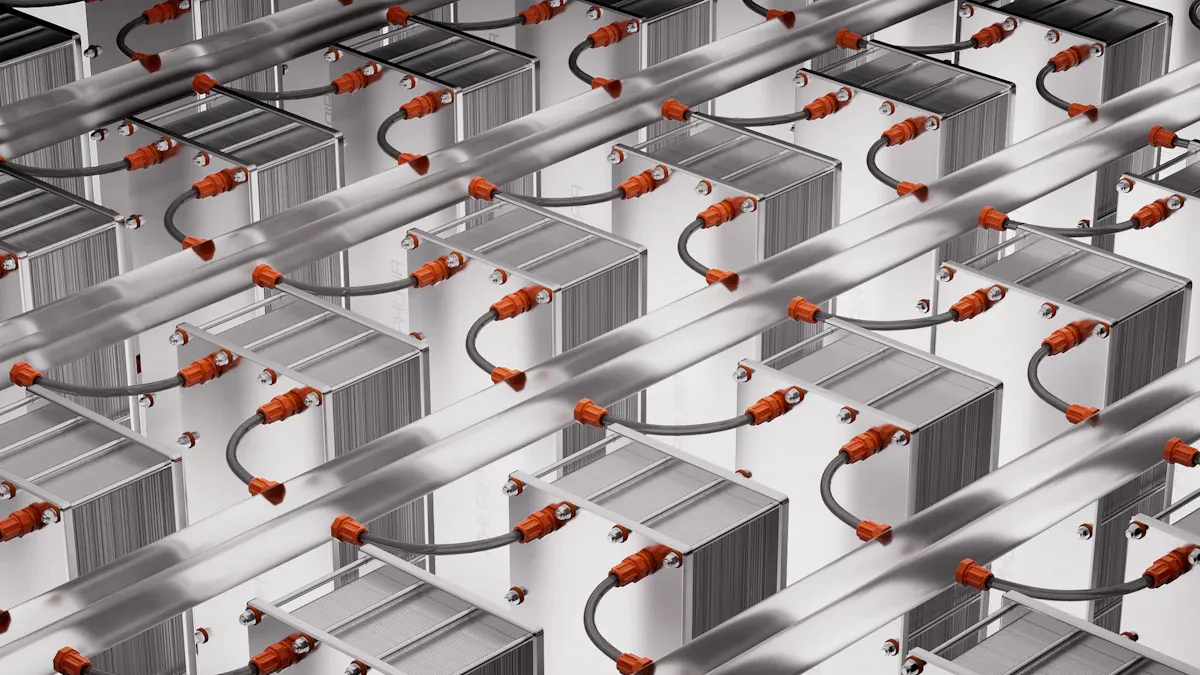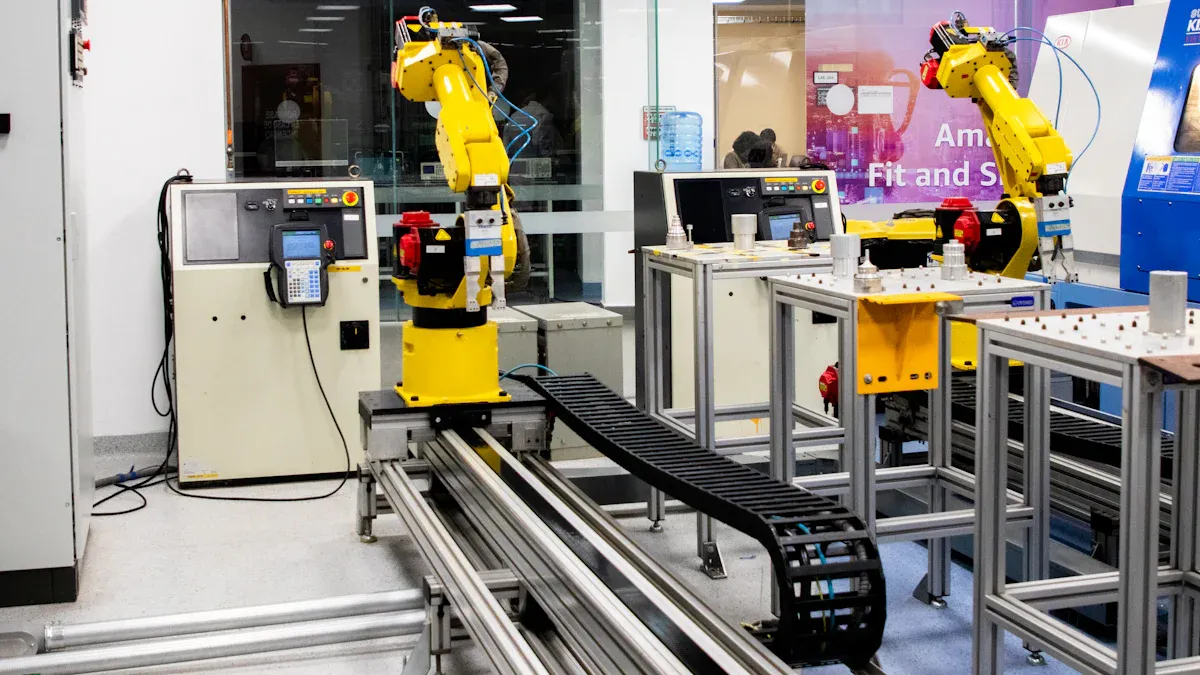
Selecting between NMC vs. LiFePO4 batteries shapes your industrial robot’s uptime, safety, and maintenance costs. See how battery choice impacts efficiency:
Battery Type | Impact on Uptime and Maintenance Costs |
|---|---|
Boosts operational duration and reduces downtime. | |
Provides reliability and minimizes maintenance needs. |
Strategic selection ensures your robots meet demanding performance and safety standards.
Key Takeaways
NMC batteries offer higher energy density, making them ideal for applications requiring compact design and longer runtime.
LiFePO4 batteries excel in cycle life and safety, providing a strategic advantage for robots in high-risk or continuous-use environments.
Choosing the right battery chemistry impacts your robot’s uptime, maintenance costs, and overall operational efficiency.
Part 1: Battery Chemistry
1.1 nmc batteries
You encounter NMC batteries frequently in industrial robotics. These batteries use nickel manganese cobalt as their core chemical components. The layered oxide structure gives NMC batteries a high energy density, ranging from 160 to 270 Wh/kg. This structure supports robust performance in demanding environments. You benefit from NMC batteries when you need consistent power delivery and minimal voltage variation during discharge. The average voltage output sits at 3.7V, which suits applications that require stable and reliable energy. NMC batteries dominate sectors like electric vehicles and consumer electronics due to their efficient energy storage and delivery.
Battery Type | Chemical Components | Structure Type | Energy Density (Wh/kg) | Cycle Life (cycles) | Applications |
|---|---|---|---|---|---|
NMC | Nickel, Manganese, Cobalt | Layered oxide structure | 160 – 270 | N/A | Electric vehicles, consumer electronics |
Lithium Iron Phosphate | Olivine structure | N/A | 2000 – 5000 | Energy storage, medical devices |
1.2 LiFePO4 batteries
You may consider LiFePO4 batteries for industrial robots that prioritize safety and longevity. These lithium iron phosphate batteries feature an olivine structure, which enhances thermal stability and reduces risk of overheating. LFP batteries typically deliver an average voltage of 3.2V. You notice that lifepo4 batteries maintain stable power delivery, though their voltage may drop more rapidly than nmc batteries. However, this drop is less pronounced compared to other lithium-ion battery technologies. LFP batteries excel in cycle life, often reaching 2000 to 5000 cycles, making them ideal for energy storage and medical devices.
Tip: When you need a battery with extended lifespan and superior safety, lifepo4 batteries offer a strategic advantage for industrial robots operating in high-risk or continuous-use environments.
NMC batteries provide higher energy density and stable voltage output.
Lifepo4 batteries deliver longer cycle life and enhanced safety.
Both chemistries support industrial robots, but your choice depends on operational priorities.
Part 2: Performance & Safety

2.1 Energy Density
When you evaluate battery options for industrial robots, energy density becomes a critical metric. Higher energy density means you can pack more electric power into a smaller, lighter battery, which directly impacts robot runtime and payload capacity. In the comparison of NMC vs. LiFePO4, you see a clear distinction.
Battery Type | Platform Voltage (V) | Average Energy Density (Wh/kg) | Cycle Life (cycles) |
|---|---|---|---|
NMC batteries | 3.7 | 160-270 | 1000-2000 |
3.2 | 100 – 180 | 2000+ |
NMC batteries deliver high energy density, often exceeding 300 Wh/kg. This advantage allows you to design compact lithium battery packs that support longer operation between charges. LiFePO4 batteries, also known as LFP batteries, offer lower energy density, typically ranging from 150 to 205 Wh/kg. You may notice that lithium iron phosphate batteries require larger packs to match the runtime of NMC batteries. However, LFP batteries compensate with other strengths.
Note: If your industrial robot needs maximum runtime and minimal weight, NMC batteries provide a strategic edge due to their high energy density.
2.2 Cycle Life
You must consider cycle life when planning for long-term operational efficiency. Cycle life measures how many full charge-discharge cycles a battery can endure before its capacity drops below 80% of its original value. In the NMC vs. LiFePO4 comparison, LFP batteries stand out for their exceptional lifespan.
LiFePO4 batteries can last over 10 times longer than NMC batteries at 100% depth of discharge.
LFP batteries often exceed 3000 full cycles, making them ideal for continuous-use industrial robots.
NMC batteries typically offer a cycle life of 500 to 1000 cycles, which may limit their suitability for high-frequency operations.
You gain significant cost savings and reliability with lifepo4 batteries, especially in applications where robots operate around the clock. The extended lifespan of LFP batteries reduces maintenance needs and replacement frequency, supporting your business’s bottom line.
Tip: For robots in demanding environments or those requiring frequent charging, lifepo4 batteries deliver unmatched longevity and reliability.
2.3 Safety
Safety remains a top priority in industrial robotics. You must address safety concerns when selecting battery chemistry for your robots. NMC batteries present several risks:
Thermal runaway can occur if NMC batteries overheat, get punctured, or experience overcharging. This may lead to fire or explosion.
NMC batteries degrade faster with frequent cycling, which can compromise safety and performance.
The mining of cobalt for NMC batteries raises environmental and ethical issues.
LiFePO4 batteries offer a superior safety profile. Their thermal and chemical stability significantly lowers the risk of combustion and thermal runaway. You benefit from reduced safety incidents and lower insurance costs. LFP batteries do not contain cobalt, which helps you avoid the environmental and ethical challenges associated with NMC batteries. The gradual failure modes of lifepo4 batteries, such as capacity loss and discharge imbalance, further enhance operational safety. Unlike NMC batteries, LFP batteries rarely fail catastrophically.
Battery Type | Common Safety Risks | Thermal Runaway Hazard | Environmental Impact |
|---|---|---|---|
NMC | Overheating, fire, cobalt mining | High | Significant |
LiFePO4 | Capacity loss, imbalance | Lowest | Minimal |
Temperature extremes also affect battery safety and performance. NMC batteries maintain discharge capacity at low temperatures but face compromised safety at high temperatures due to thermal runaway risks. LiFePO4 batteries show some performance degradation in extreme conditions but remain safer overall. Effective thermal management and a robust battery management system (BMS) are essential for both chemistries.
Safety tip: Always implement a BMS to monitor temperature and prevent overheating in lithium-ion batteries used in industrial robots.
You must weigh energy density, cycle life, and safety when choosing between NMC vs. LiFePO4 for your industrial robot fleet. Your decision will shape operational uptime, maintenance costs, and risk management.
Part 3: Application Suitability

3.1 Heavy-Duty Robots
When you deploy heavy-duty robots in industrial settings, you need batteries that deliver reliability and long service life. LiFePO4 batteries stand out for these applications. You benefit from their high safety and stability, which reduces downtime and risk. LFP batteries offer large-capacity formats, supporting extended operation in demanding environments. You also gain from their long cycle life, often exceeding 3,500 cycles and potentially reaching 6,000 cycles as technology advances.
LiFePO4 batteries provide superior thermal stability, minimizing overheating risks.
You experience lower operational costs due to fewer replacements and maintenance.
LFP batteries support frequent charge-discharge cycles, which is essential for heavy-duty robots.
NMC batteries offer higher energy density, but their shorter cycle life and increased safety risks make them less suitable for continuous heavy-duty use.
3.2 Mobile Robots
Mobile robots, such as autonomous mobile robots (AMRs), require batteries that balance weight and runtime. You notice that battery weight directly affects mobility and efficiency. NMC batteries deliver high energy density, allowing longer operation without adding extra weight. This feature is crucial for mobile robots in logistics, robotics, and infrastructure applications.
NMC batteries maximize runtime and payload capacity.
LFP batteries offer enhanced safety and longer cycle life, which benefits robots operating in unpredictable environments.
You must consider the trade-off between energy density and safety when selecting batteries for mobile robots.
Tip: For mobile robots where efficiency and runtime are critical, NMC batteries provide a strategic advantage. If your application prioritizes safety and longevity, lifepo4 batteries are the better choice.
3.3 Specialized Uses
Specialized robots in medical, security, and consumer electronics industries require tailored battery solutions. You must evaluate several factors before choosing the optimal battery chemistry.
Consideration | Description |
|---|---|
Battery Chemistry | Select LFP batteries for frequent charge-discharge cycles and high safety. |
Safety Features | Ensure batteries have built-in protections like over-voltage and thermal management. |
Environmental Compatibility | Confirm batteries operate within the robot’s temperature range and meet IP ratings. |
Battery Voltage and Capacity | Match battery voltage and capacity to the robot’s operational needs. |
Discharge Current | Verify batteries can handle peak energy demands for power-intensive tasks. |
Battery Lifespan | Choose batteries with long cycle life to reduce maintenance and operational costs. |
Communication Protocol | Ensure compatibility with protocols such as CAN or RS485. |
You improve performance and reliability by matching battery chemistry to your robot’s operational requirements. LFP batteries excel in safety and cycle life, making them ideal for hazardous environments and medical devices. NMC batteries suit applications where energy density and compact design are prioritized, such as consumer electronics and commercial and industrial robots.
Part 4: Trade-offs & Trends
4.1 Environmental Impact
You face increasing pressure to select batteries that minimize environmental harm. LiFePO4 batteries use iron, which is abundant and easy to recycle. This makes lifepo4 a more sustainable choice compared to NMC batteries, which rely on cobalt and nickel. Cobalt mining often leads to human rights abuses and environmental degradation. You can learn more about conflict minerals here. LiFePO4 batteries also produce lower greenhouse gas emissions, with an intensity of 55 kgCO2eq/kWh, outperforming nickel-based chemistries. When you consider end-of-life disposal, lifepo4 batteries offer innovative recycling methods that use less energy and generate fewer harmful emissions. NMC batteries have a more established recycling infrastructure, but their recycling process creates significant environmental impact. For a deeper look at sustainability, visit our approach to sustainability.
Battery Chemistry | Key Materials | Cobalt Content | Greenhouse Gas Emissions (kgCO2eq/kWh) | Recycling Impact |
|---|---|---|---|---|
NMC | Nickel, Manganese, Cobalt | High | Higher | Significant |
LiFePO4 | Iron Phosphate | None | 55 | Minimal |
Note: You reduce ethical and environmental risks by choosing lifepo4 batteries for your industrial robot fleet.
4.2 Integration
You must evaluate integration challenges when deploying lithium battery packs. Lifepo4 batteries last over 10 times longer than NMC batteries at 100% depth of discharge. This longevity supports long-term deployment and reduces replacement frequency. You find lifepo4 batteries ideal for energy storage and renewable grid integration due to their safety and cost-effectiveness. NMC batteries excel in high-rate performance and fast response, which suits UPS and grid frequency regulation. The higher energy density of NMC batteries affects shell design and cost considerations. Housing costs for lifepo4 batteries are about 1.2-1.5 times higher than NMC due to construction, cooling, and safety components. Both chemistries offer similar round-trip efficiency, but lifepo4 batteries provide a higher temperature threshold for thermal runaway.
Lifepo4 batteries deliver longer cycle life and stability.
NMC batteries offer compact design and high energy density.
You must balance cost, safety, and performance when integrating batteries into industrial robots.
4.3 Future Trends
You see rapid growth in the global battery market, driven by technological advancements and sustainability efforts. The demand for lifepo4 batteries is rising as industries seek safer and more efficient energy storage for industrial robots and electric vehicles. Market projections show strong growth:
Year | Market Size (USD Billion) | CAGR (%) |
|---|---|---|
2024 | 12.23 | – |
2033 | 45.67 | 16.5 |
You notice a shift toward localized supply chains and improved recycling. NMC batteries remain popular for high energy density, while lifepo4 batteries gain preference for safety and longevity. Advancements in battery technology will enhance performance, safety, and cost-effectiveness, making both chemistries more suitable for mobile robots in logistics and warehousing. For large-scale deployments, lifepo4 batteries offer significant cost advantages, as their raw materials cost about a third or less compared to NMC batteries. You can scale capacity by connecting batteries in parallel, supporting fleet expansion and increased productivity.
Tip: You maximize operational efficiency and sustainability by staying informed about battery market trends and technological innovations.
You face a clear choice in the nmc vs. lifepo4 debate. Review the table below to compare key trade-offs for your battery selection:
Feature | NMC vs. LiFePO4 |
|---|---|
Energy Density | Higher (NMC) |
Cycle Life | Longer (LiFePO4) |
Safety | Superior (LiFePO4) |
Select NMC for compact, high-power robots. Choose LiFePO4 for safety and longevity. Expect rapid advances in batteries to further optimize industrial robotics.
FAQ
What factors should you consider when choosing between NMC and LiFePO4 battery packs for industrial robots?
Factor | NMC Batteries | LiFePO4 Batteries |
|---|---|---|
Energy Density | High (300 Wh/kg) | Moderate (150-205 Wh/kg) |
Cycle Life | 500-1000 cycles | 3000+ cycles |
Safety | Moderate | Superior |
You should match battery chemistry to your robot’s runtime, safety, and maintenance needs. Consult Large Power for tailored solutions.
How does cycle life impact your total cost of ownership for lithium battery packs?
You reduce replacement frequency and maintenance costs by selecting LiFePO4 batteries. Longer cycle life supports continuous operation and lowers your total cost of ownership.
Can you customize lithium battery packs for unique industrial robot requirements?
You can request custom lithium battery packs from Large Power. Their engineers design solutions for voltage, capacity, and communication protocols. Request a custom battery consultation for your project.




